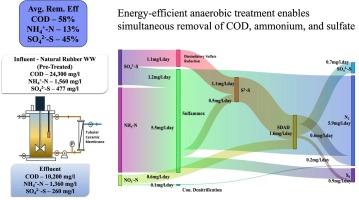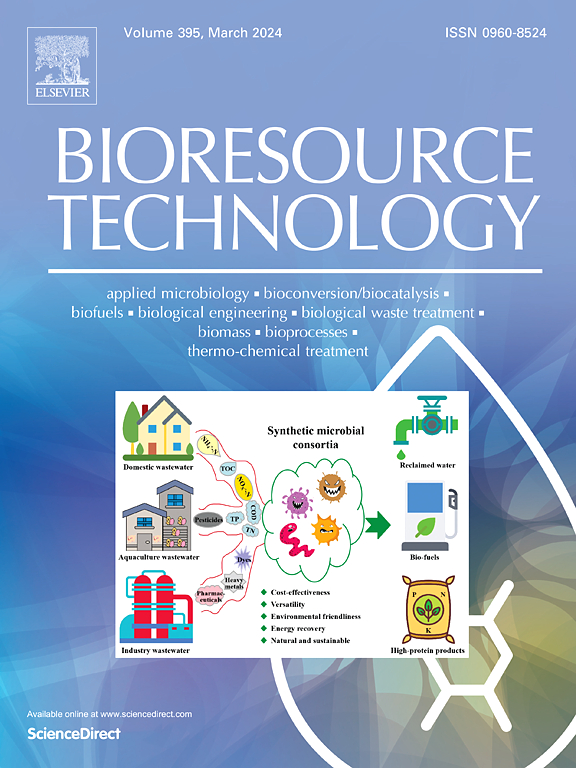通过在厌氧膜生物反应器中耦合硫熏毒素和硫化物驱动的自养反硝化作用,同步去除橡胶工业废水中的氮和硫酸盐。
IF 9.7
1区 环境科学与生态学
Q1 AGRICULTURAL ENGINEERING
引用次数: 0
摘要
全球橡胶工业每年增长 4-6%,2019 年橡胶产量将达到 1376 万吨,对经济产生重大影响。本研究探讨了在厌氧膜生物反应器(AnMBR)中耦合硫酸盐依赖性铵氧化(Sulfammox)和硫化物驱动的自养反硝化(SDAD)来处理高强度天然橡胶废水。在 225 天内,厌氧膜生物反应器系统的化学需氧量(COD)、总氮(TN)、铵态氮(NH4+-N)和硫酸盐硫(SO42--S)的最大去除率分别达到 58%、31%、13% 和 45%。TN 主要通过硫代甲氧基(占 NH4+-N 去除率的 49%)、SDAD 和传统脱氮途径去除。硫酸盐的去除则是通过硫熏毒素(占 SO42-S 去除量的 43%)和溶解性硫酸盐还原 (DSR) 过程(占 SO42-S 去除量的 57%)实现的。微生物分析发现,脱硫弧菌和硫螺旋体是关键微生物,而元基因组分析则强调了关键的硫和氮循环途径。研究结果支持将 Sulfammox 和 SDAD 作为处理富含氨和硫酸盐的工业废水的生态友好型策略。本文章由计算机程序翻译,如有差异,请以英文原文为准。

Synchronised removal of nitrogen and sulphate from rubber industrial wastewater by coupling of Sulfammox and sulphide-driven autotrophic denitrification in anaerobic membrane bioreactor
Global rubber industry, growing 4–6 % annually with 13.76 million Mt of rubber produced in 2019, significantly impacts the economy. This study explores coupling sulfate-dependent ammonium oxidation (Sulfammox) and sulfide-driven autotrophic denitrification (SDAD) within an anaerobic membrane bioreactor (AnMBR) to treat high-strength natural rubber wastewater. Over 225 days, the AnMBR system achieved maximal chemical oxygen demand (COD), total nitrogen (TN), ammonium nitrogen (NH4+-N), and sulfate sulfur (SO42−-S) removal efficiencies of 58 %, 31 %, 13 %, and 45 %, respectively. TN is predominantly removed through Sulfammox (accounting for 49 % of NH4+-N removal), SDAD, and conventional denitrification pathways. Sulfate removal is achieved via Sulfammox (responsible for 43 % of SO42−-S removal), and Dissimilatory sulfate-reducing (DSR) processes (contributing 57 % of SO42−-S removal). Microbial analysis identified Desulfovibrio and Sulfurospirillum as key microbes, while metagenomic analysis highlighted crucial sulfur and nitrogen cycling pathways. The findings support Sulfammox and SDAD as promising eco-friendly strategies for treating ammonia- and sulfate-rich industrial wastewater.
求助全文
通过发布文献求助,成功后即可免费获取论文全文。
去求助
来源期刊

Bioresource Technology
工程技术-能源与燃料
CiteScore
20.80
自引率
19.30%
发文量
2013
审稿时长
12 days
期刊介绍:
Bioresource Technology publishes original articles, review articles, case studies, and short communications covering the fundamentals, applications, and management of bioresource technology. The journal seeks to advance and disseminate knowledge across various areas related to biomass, biological waste treatment, bioenergy, biotransformations, bioresource systems analysis, and associated conversion or production technologies.
Topics include:
• Biofuels: liquid and gaseous biofuels production, modeling and economics
• Bioprocesses and bioproducts: biocatalysis and fermentations
• Biomass and feedstocks utilization: bioconversion of agro-industrial residues
• Environmental protection: biological waste treatment
• Thermochemical conversion of biomass: combustion, pyrolysis, gasification, catalysis.
 求助内容:
求助内容: 应助结果提醒方式:
应助结果提醒方式:


